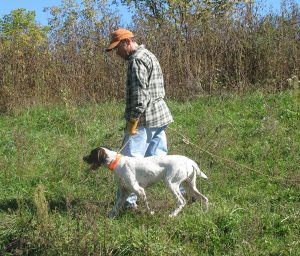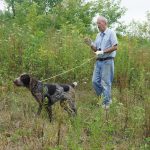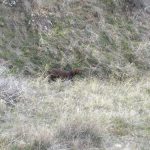Bird Dogs and Yard Work – Timing is Everything!
POINTING DOG POINTERS
By Bob and Jody Iler
Just what the heck do we mean by “yard work,” anyway? With pointing dogs, we refer to the basic commands of here (come), heel and whoa as yard work. In more advanced training, yard work plays an important part in steadying a dog to wing and/or shot, honoring (backing), stopping to a wild flush, and “handling kindly” in the field. You might say that yard work is the bird dog version of obedience training. We should add, however, that many top-notch dogs can also excel in formal obedience training and earn AKC obedience titles.
And what about “timing”? Why is it “everything”? Think about an Olympic athlete: Before he evolves into a disciplined competitor, that athlete first stretches the limits of his abilities – giving it his all with zest and abandon. Likewise, if a budding writer is too preoccupied with word count, grammar, and style guides, some of the writer’s best work will never emerge on the page, because he or she is worried about those restrictions.
Enter your pointing dog pup.
Back in the 2005 March/April issue of The Pointing Dog Journal, we wrote an article, “Shuffle the Cards,” where we noted that key to the introduction of yard work is the fact that first and foremost, you have a bird dog! And second, every pup is different, therefore yard work should be introduced accordingly. Timing is everything!
Like the budding athlete, your pointing dog pup needs to have that part of her genetics awakened first, before any restrictions inhibit what is inherently there, waiting to be brought out. In a pup’s early months of development, everything should be positive and fun, especially if she is reserved or “soft” in temperament. Overuse of control and obedience training can intimidate the young dog. We want to encourage confidence, independence, and enthusiasm for birds, letting the “pointing dog” part of our pup’s makeup emerge freely.
This is not to say that you won’t need to instill basic control work in your pup. Bold pups may need guidance early on in the form of gentle, firm control. If your pup was the first to scramble out of the whelping box and eagerly headed for parts unknown, it’s a good bet that this pup will need control sooner than his thoughtful, deliberate littermate that watched while Mr. Big Stuff made his getaway.
Certain breeds and bloodlines, such as those of big-running, all-age type pointing dogs, are often schooled in yard work before field and bird work are begun, without any resulting issues. But even among this group, there may be a soft type that would benefit more from having bird work introduced first, before control work.
For the average or novice pointing dog owner who wants a great hunting dog or may want to compete in field events too, you can’t go wrong if you focus on developing the pup’s love for birds first. All the rest will come. You can put control into a dog anytime. But we’ve had six-month-old pups come into our kennel that will hang close to us in the field and be unwilling to range out and have fun because they’ve been “obedience trained” by their proud owners.
Once your pup is housebroken and comfortable with the home environment and routine, it’s time to do some evaluating as you spend time together. Is your pup ready to explore without reservation? Does your pup pull you along with enthusiasm for whatever’s next? Or does your pup hang back, and act a little reserved or even timid with new and different experiences? Take time to read your pup in different scenarios. At this time, it’s fine to teach your pup to come here and reward with a treat. It’s good to let the pup learn to walk on a lead without balking. It’s good to spend time together playing and checking out new places. But that’s all you should do at this stage.
Next should come gentle bird introduction. You can learn how to do this yourself, work with a trainer, or send your pup to a professional. When clients ask us what they should do in regard to obedience training before they bring their pups to us, we say, “Nothing!” Love them, bond with them, teach them basic manners, etc., but leave the rest to us.
We’ll start by introducing that young pup to birds and begin to read what the pup is telling us over several sessions in the field. One pup may jump back fearfully when he encounters a bird. One pup may jump in and grab the bird, maybe even running off with it! One pup may point first, and then jump in. The “obedience-trained” pup may still be at our side, needing encouragement to get out there, have fun, and find the bird. Determining the pup’s temperament will help us figure out the yard work program for that particular pup.
Bold, enthusiastic young dogs will usually pay no heed to the checkcord that we put on them to introduce some control in the field. As we get them bird crazy, we can also start teaching them to respond to the checkcord and to our command to come here. We don’t overdo this! We’ll also encourage the pup, with the checkcord, to change directions as we indicate, using the checkcord to “pop” him, while beginning simple whistle work. With these pups, we’ll also start a yard work program, which will include gentle heeling and introducing him to a puppy whoa (having him stand at heel) when we stop walking.
With the pup that has not shown much enthusiasm in the field or on birds, or that does not want to leave our side, or was reluctant to even go to the field, we’ll start from scratch. We want no controls at all used on this type of pup. We want to take him back to his baby days, where he can romp around and not worry about what we want from him. We’ll focus on building this pup’s confidence, enthusiasm, and abandon. You might say that we will “de-train” this pup. We want to make him into an outlaw! What good is a well-trained pointing dog if he doesn’t want to find birds and is so well-behaved that he won’t take off and check out the field?
Teaching your pointing dog to handle well in the field, to come when called, to heel nicely at your side, and to whoa on command are all important elements in the development of a class bird dog. But learning to read what your young pup is trying to tell you – and knowing when and how to begin his yard work – will help ensure his future success.
Pointing Dog Pointers features monthly training tips by Bob and Jody Iler, who own Green Valley Kennels in Dubuque, Iowa. Bob and Jody have trained pointing dogs for over 35 years and have written many articles for The Pointing Dog Journal.







